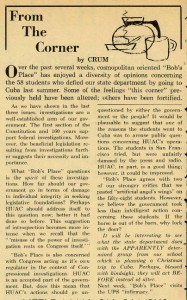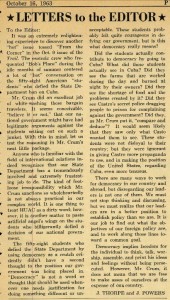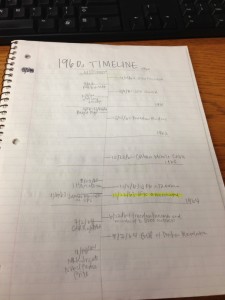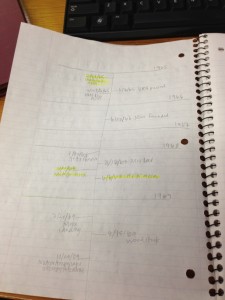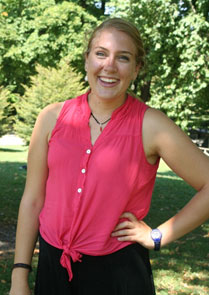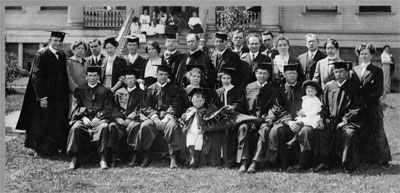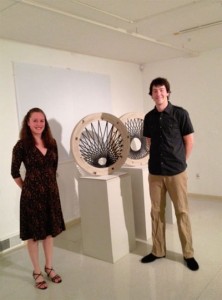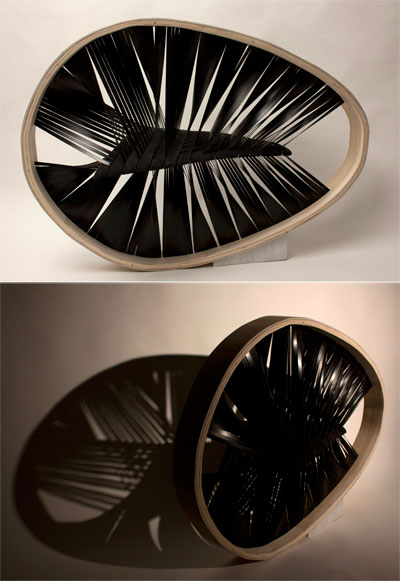Criteria for selection:
Awards will be granted based on a combination of factors including, but not limited to, originality, creativity, content integration, unity of form, craftsmanship, reader/viewer engagement and conceptual strength.
COLLINS MEMORIAL LIBRARY AWARD
At the request of the Library Director, 2-4 representatives of the University of Puget Sound will select one work for the award. Participating in the award selection are:
Peggy Burge: Humanities Librarian
Julie Christoph: Director of the Center of Writing, Learning and Teaching and a supporter and user of our collection
Katie Henningsen: Archivist and Digital Collections Coordinator
Hilary Robbeloth, Metadata Librarian.
Both Hilary and Katie are working with cataloging and preserving our current collection.
Criteria for selection:
The Collins Memorial Award will be granted based on a combination of factors including, but not limited to, originality, creativity, content integration, unity of form, craftsmanship, reader/viewer engagement and conceptual strength.
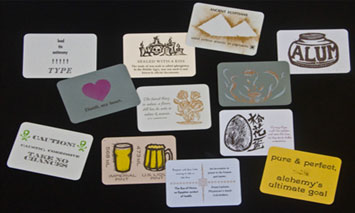
A Strange Case of Alchemical Munificence by the Elliott Press
Elliott Press~Jessie Ehman, Jakob Maier, Stephanie Beckman, Brandi Smith, Jen Arbaugh, Leah Thomas, Mark Larkin, Taylor Andringa, Allison McDaniel, Malena Goerl, Colin Mischel, Morgan Knowles, Jacob Ooley, Kelsey Johnston, and Nick Sanford
Tacoma, WA
A Strange Case of Alchemical Munificence (2013)
About this book:
Letterpress printed cards, pochoir, linoleum carving, ornaments and more than 99 alchemical symbols donated to the Elliott Press by Dr. Shaw in the 1980s. Cards are 3 x4 inches housed in a 4 x 6 x .75 inch box, 99 pages. This work is an edition of 33.
The number 9 plays a significant role in the noble art of alchemy. Symbolic of perfection and attainment, satisfaction and completion, the number 9 is concerned with intellectual power and the journey towards spiritual enlightenment.
The ninth tarot card in the Major Arcana is represented by the Hermit-oftentimes viewed as an alchemist who travels the world with only his secret knowledge to guide him.This deck-divided into 9 distinct categories-explores the fundamental meaning of 17th century alchemical symbols left to us by Dr. John Shaw, a dermatologist and hobby printer.
springjl@plu.edu
https://sites.google.com/a/plu.edu/ppa-program/ Elliott Press
We selected A Strange Case of Alchemical Munificence by the Elliott Press for its aesthetic appeal, as well as for its broad disciplinary applications and its potential to inspire collaborative work. We envision A Strange Case being of interest to students in the history of science, religion, creative writing, and art. We were especially impressed with the way in which this piece models the collaborative process and demonstrates that a relatively large group of artists can produce a cohesive piece of work. The tactile nature of the piece invites us to play with it to create new meanings.
RECOGNITION OF EXCELLENCE AWARD
The curators of the 2013 exhibition have invited Megan Benton to select the work for the 2013 Recognition of Excellence Award.
Megan Benton: Former Director of the Publishing and Printing Arts Program (including the Elliott Press) at Pacific Lutheran University, author of Beauty and the Book: Fine Editions and Cultural Distinction in America (New Haven: Yale University Press, 2000), MFA-University of Alabama
Criteria for selection:
The Recognition of Excellence Award will be granted based on a combination of factors including, but not limited to, originality, creativity, content integration, unity of form, craftsmanship, reader/viewer engagement and conceptual strength.
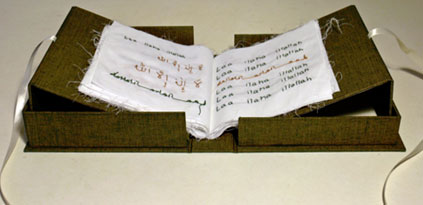
Arini Esarey for “Laa ilaha illallah”
Laa ilaha illallah (2012)
About this book:
Two-section pamphlet sewn book with custom-made cradle box, cotton cloth, embroidery thread, ribbon, bookboard and bookcloth; 8 x 7.5 x 2.25 inches, 25 pages. This work is unique.
This book was made as a reflection on my mother and the role of faith in her life. She hand-wrote these words in Arabic and their English transliteration, which I then copied and embroidered 100 times.
The phrases are stitched in random arrangement on recto and verso so the front and backs of the stitching are exposed as one turns the pages.
I hope that the pacing will cause viewers to read through this book mindfully. Through this project I hope to unite my sources of joy and contemplation with hers and thereby gain understanding of her perspective.
ariniesarey.com
Arini Esarey
I am an artist, bookbinder, and conservator currently based in Walla Walla, WA. Conceptually, I engage in work concerned with the simple ways we find delight in connecting with something larger than ourselves, whether that be other people, nature, or the divine. Such work is created by means that are repetitive in motion, rooted in traditional crafts, or that rely on the cycles of nature.
This work succeeds beautifully on many levels. The meditative nature of the simple text is mirrored in the work’s formal qualities, especially the use of repetition and hand-sewing, long associated with women’s reflective spirituality across many faiths and cultures. The fraying edges of each cloth sheet further echo the thread-made words, and the stitched undersides of each page (in a nice literal illustration of the term verso) similarly help the incantation linger, visually and substantively. In effect the book embodies a religious chant in ways that give it dignity, honor, and depth. The craftsmanship of the solander box is also excellent, and the enclosed cradle, with end flaps that fold to create a lectern, is a thoughtful and unifying design element.
CURATOR’S CHOICE AWARD
Curators:
Patricia Chupa: Book artist from Olympia, WA. Her work showcases a range of artistic and literary pursuits, generated from her interest in book arts, letterpress printing, writing, book binding, proofreading, beta reading, copy editing, indexing, and leading workshops.
Debbi Commodore: Book artist, relief printer (linoleum/woodblock/letterpress) from Tacoma, WA.
Deborah Greenwood: Collage and book artist from Tacoma, WA. She studied art at the Columbus College of Art and Design and earned a doctorate in Mythology and Depth Psychology at Pacifica Graduate Institute. Interest in these areas fuel her visual explorations in collage-based books. Her books are collected by university libraries and art schools.
Kay Govan: Katy Govan has a BFA in Photography and an MFA in Book Arts. She is a college art instructor and also leads workshops in both subject area. She currently lives in Olympia, WA.
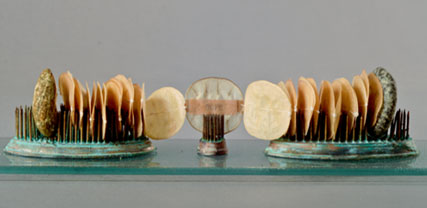
Lynn Knopp, Trilogy of Hope: on the horns of a dilemma
Lynne Knopp
Bainbridge Island, WA
Trilogy of Hope: on the horns of a dilemma (2012)
About this book:
Accordion-style structure, Lunaria pod pages, waxed beadstring, beach-rock cover, antique Japanese frogs, and recycled glass shelf; 1.375 x 1.5 x 1.5 inches (opens to 25 inches), 30 pages. This work is unique.
There is a fragility to life and an indomitable nature of the human spirit. From the oldest living survivor of the holocaust, whose son conveyed that he was given such extraordinary security while living in a concentration camp that “in the middle of hell, my mother created a Garden of Eden for me” to a badly burned child, who rallied after being visited by a volunteer teacher: “It is not likely they would teach adverbs to a dying boy”.
Hope is the last thing ever lost, but it is often found in the most precarious of places.
lynneknopp@hotmail.com
Lynne Knopp
My books are tributes to the Art of Procrastination. At times I am drawn to a certain material and/or technique, while other times I am inspired by a call for entry. My process is often convoluted as I collect the components for a finished product and think through problems for weeks, months and often years!
The Curators’ Choice Award for 2013 is given to Lynne Knopp, for Trilogy of Hope: on the horns of a dilemma. The team felt that this work embodies in itself all of the criteria for selection. The original vision of the artist – to convey a universal concept that is both constant and also fragile; her inspired choice of durable and timeless rock for a cover, and the fleeting, ephemeral and transitory nature of the Lunaria pod leaves as pages sheltering the text; the clever use of flower frogs giving eloquent voice to the reality of the prickly and hostile environment in which Hope abides – all these elements provide a wonderful enticement to reflect on the message it holds.

